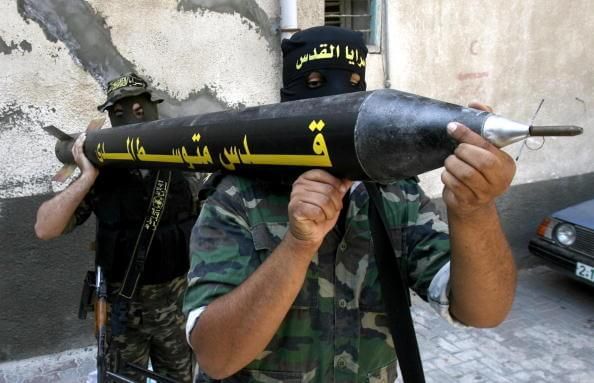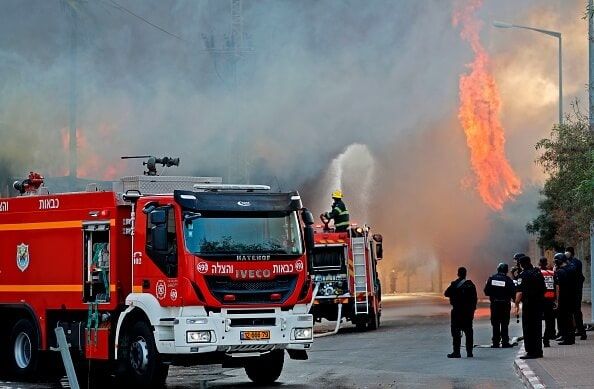Imagine if you lived in New York City and every few weeks, explosive projectiles were fired indiscriminately over the River Hudson from New Jersey. How would you cope being caught in the open during such an attack? What about your children? Would you sleep soundly knowing that you might be woken in the dead of night by a siren giving you 15 seconds to get to a reinforced room or a bomb shelter?
Since 2001, Palestinians have launched thousands of rockets and mortars from Gaza towards Israeli communities in the south of the country, and sometimes even beyond. While Israeli casualties have been low in proportion to the number of rockets fired, this is not from a lack of incentive on the part of Palestinian terrorists who are attempting to cause as many deaths and injuries as possible.
But the impact of such attacks goes beyond the potential for physical harm. The disruption to the lives of Israelis under constant threat is tangible not to mention the psychological effects, particularly to children.
Join the fight for Israel’s fair coverage in the news
‘Home made’ rockets?
The media often downplay the threat by virtue of the misleading description of Gaza rockets as ‘home made.’ The most well-known, the Qassam rockets are home made but only in the sense that they are locally produced using crude materials and explosives packed into the warheads. This does not, however, mean that they are any less deadly. Qassams, inaccurate and lacking any guidance system, can only be fired indiscriminately towards population centers. With a limited range, Qassams were and are fired at Gaza border area towns and communities such as Sderot.

Over the years, however, Palestinian terror organizations have upgraded their armory with more sophisticated rockets including Katyushas, WS-1Bs, Grads, locally-made “M-75” and Iranian Fajr-5 rockets, putting most of Israel’s population within range.
Iran has played a major role in supporting both Hamas and Islamic Jihad financially and with attempts to smuggle weapons, including upgraded rockets, into Gaza. The Israeli and Egyptian blockade of Gaza is in place mainly to prevent such smuggling.

Economic impact and disruption to life
Israel’s south is considered to be part of its economic periphery. Much of the population, particularly in towns such as Sderot, are from middle to lower income sectors of society. Even if residents wished to leave the area, their ability to do so is hampered by the much higher property prices in other parts of the country. The security situation makes it considerably harder to sell at a price high enough to afford to buy elsewhere.
For the kibbutzim and moshavim in the area, community is paramount. But the ability of these communities to grow or at least maintain themselves depends on either attracting new members or keeping the next generation from moving away to other parts of the country. While the sense of community and the incredible resilience of the residents has by and large held, the security situation places an enormous strain on them.
Living under rocket threat has severely impacted the local economy. While industries may be attracted by the cheaper land, many will consider the risk too high. Without local industry, there are fewer local employers. If the local population is living on low wages or even unemployed, local municipalities are unable to collect enough taxes to provide for quality services for residents. Equally, municipalities rely on business taxes for their budgets.
In November 2019, during a particularly intense rocket barrage, one rocket hit a mattress warehouse in the Hollandia factory in Sderot, igniting a major blaze. Several firetrucks were called to tackle the blaze, though their efforts were hampered by frequent rocket alerts that forced them to stop their activities and seek shelter themselves.

CEO Avi Barssessat told Israeli media that the 4,000-square-meter building, which was in danger of collapse, was full of products waiting to be delivered to clients.
“I am seriously hurt by this situation,” Barssessat said. “It’s true that I’m not bleeding from anywhere, but the damage is huge. I am completely destroyed seeing my life’s work going up in flames.”
While measures such as the Iron Dome, warning sirens, reinforced rooms and bomb shelters have minimized the damage and loss of life, even one rocket fired from Gaza has the potential to cause extreme disruption to daily routines. Just the siren itself is the cue for residents to drop whatever they are doing and take cover sometimes with as little as 15 seconds. Schoolchildren abandoning their lessons; office workers running to the safe room; shoppers lying on the ground hoping for the best.
Related reading: Israel’s Disproportionate Civil Defense
Any flare up of violence caused by rocket barrages can cause even greater disruption. In February 2020, for example, close to 100 rockets fired over two days from Gaza prompted the IDF Home Front Command issued a series of precautionary directives for southern Israel, closing schools, banning large outdoor gatherings, restrictions on carrying out agricultural work close to the Gaza border, blocking roads and halting train services. As a result of the precautionary school closures, 55,000 students stayed home.
Related reading: From the Scene: Under Fire in Israel’s South
Psychological trauma
The residents of the south have lived under the threat of Gaza rockets for nearly two decades. While the numbers of deaths during that period have been relatively low (thanks in the main to Israeli measures to protect its citizens), the impact on the mental health of those living there has been tangible.
Post-trauma specialist Yehudit Spanglet, spoke to the Jewish Press in June 2019 about the situation in Sderot:
Without question there are hundreds of people in Sderot and southern Israel who live in a state of continuing trauma. Not only from the rockets which fall, but also from the booms of the Iron Dome defense system which, baruch Hashem, intercepts most of the incoming rockets. The blasts which resound in the sky can continue to echo in a person’s ears long after the attack.
Many victims of trauma live in fear, even during extended periods of ceasefire. When they announced that no one was injured in last Thursday’s rocket attack, I laughed. Every time the siren wails and people have to run for cover, the trauma damage from previous attacks is reinforced.
Once when I was visiting Sderot, the city came under attack. Outside on the street, not far from my daughter’s home, a woman stood paralyzed, staring up at the sky. Her neck had frozen in fright when the warning siren sounded. Before she could reach a bomb shelter, the missiles of the Iron Dome exploded, seemingly over her head.
Her husband didn’t want to take her to the hospital in Ashkelon. Slowly, we walked her home with her head still gazing up toward heaven. When she was back in her house, after speaking with her for half an hour, her neck muscles loosened and finally her body relaxed.
Related reading: How Israelis Cope With the Gaza Rocket Threat
The impact on children is even more pronounced. In 2015, a study found that 40% of children in Sderot experience symptoms of anxiety, fear, and post-traumatic stress disorder (PTSD) including: separation anxiety, regression to behavior befitting earlier ages, trouble sleeping, developing new fears, and anger issues. The Jerusalem Post reported:
Even during wartime, the level of PTSD among children nationwide hovers is somewhere between 7 and 10 percent, Prof. Ruth Pat- Horenczyk explained.
“The ongoing situation in Sderot causes PTSD at a rate three or four times greater than that of the rest of the country,” she said.
Similar studies over the years have found even higher rates of PTSD in children living in border communities that have suffered from Gaza rockets and associated violence. That the rate has decreased somewhat is testament to the resilience of these communities and to the fact that regular flare ups of violence have become normalized – a situation that would be considered unacceptable for any country in the world with responsibility for protecting its citizens.
Sadly, with little in they way of a solution on the horizon, the residents of Israel’s south will likely face many Gaza rockets in the future. When it comes to the Gaza Strip, the next flare up or war is a question of when, not if.
Enjoyed reading this article? Follow the Israel In Focus page on Facebook to read more articles explaining Israel’s history, politics, and international affairs. Click here to learn more!


